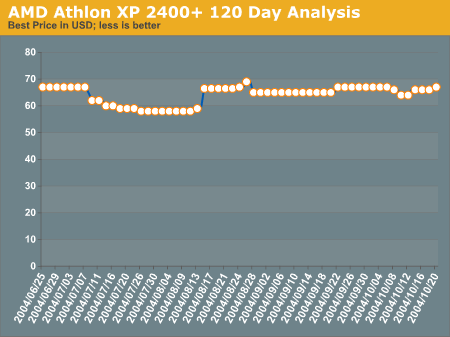Price Guides: CPU and Motherboards, October II, 2004 Edition
by Adam Rader on October 24, 2004 12:05 AM EST- Posted in
- Guides
AMD Processors - Athlon XP
As always, no guide would be complete without mention of the tried and true Athlon XP series of processors. They've been around for quite some time now, but they still have the ability to pack a pretty solid punch. Prices on these chips seem to have been going up slowly, but surely, as AMD tries to push everyone towards their more competitive and newer products such as the Athlon 64. So, if an XP is what you are looking at, then the sooner you buy, the better off you will be. Athlon XP's still have their place among budget gamers and average desktop users. On the budget side of things, the Athlon XP 2400+, which is clocked at 2.0GHz, can be had for less than $70 shipped and is more than enough juice to get through office applications, compressing zip files, and so forth. Being based on the aging Thoroughbred core, this chip is definitely not going to be around for much longer in the retail market, which tells us that their prices aren't likely to go up much more, if at all.
For a beefier CPU solution, the Barton based Athlon XP Mobile 2500+ is a great choice as it allows for two major options: extreme overclocking or low heat output at stock speeds. In either case, the performance will definitely fuel your gaming needs for a while longer without breaking the bank.











9 Comments
View All Comments
slurmsmackenzie - Monday, October 25, 2004 - link
what about 915 for 775? PCIe, ddr2 and ddr (4gb each), high definition audio. the asus p5gdc deluxe is an extremely versitile board than overclocks well all for 160 dollars. i just think it was awkward not to even mention the asus 915p and the gigabyte 915p lines. there are other options than the overpriced uncompromising 925 chipset.Rainman - Sunday, October 24, 2004 - link
For those who care, the Abit AA8 DuraMax has a $50 rebate on it making it only 102 dollars shipped from NewEgg.As usual, great work on the guide.
Gioron - Sunday, October 24, 2004 - link
I think #1 is talking about the wierd curves in between the yellow dots on the nforce2 motherboard graph on page 8. I'm not exactly sure whats going on in that graph either, and it probably wouldn't hurt to straighten all the blue lines.Other than that comment, I like the new format. Much more informative with the 120 day graphs and expanded comments. It looks like its a quite a bit more work than the previous style price guides, but it turned out well.
SUOrangeman - Sunday, October 24, 2004 - link
#1, I actually found the 120-day price analysis rather interesting. Perhaps they're worth keeping with the most dramatic changes are shown.FOr instance, there is no point in showing that data if only one vendor has product X and they never change the price. However, we may see some interesting supply-demand trends on products that are widely available (OK, more demand, than supply since it is widely available)
-SUO
AtaStrumf - Sunday, October 24, 2004 - link
I found this in your A64 pricing table:**9** Athlon 64 (939) 3200+ 512KB 90nm NewEgg 265.00 3.99 268.99 **110028** Check Prices
I think it need to be removed, since its doubled and makes no sense.
eetnoyer - Sunday, October 24, 2004 - link
Nice format. One thing to fix on pg.4 though..."One very nice attribute of the Sempron is that certain models make it very easy to adopt a newer socket 754 architecture without having to fork over the full cost of an Athlon XP..."
I think that should say Athlon 64
thebluesgnr - Sunday, October 24, 2004 - link
Very nice article, well done!Only thing missing is pricing on KT600/KT880 motherboards.
AnnoyedGrunt - Sunday, October 24, 2004 - link
What's up with Newegg and their almost $50 price increase on the 939 3200+At the current price, it really isn't a very good deal.
I haven't been that impressed with Newegg, and this price gouging certainly doesn't help their case.
Hopefully that price will come back down when the chip becomes more readily available.
-D'oh!
Chuckles - Sunday, October 24, 2004 - link
For future guides, would it be possible to eliminate the spline curves connecting the points? Right now they are a bit of a distraction, as they don't portray the local trends of the curves.Also the page 12 chart is showing the trend in price of the Abit IC7-G MaxII rather than the AA8 as recommended.